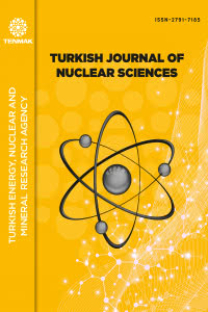IĞDIR REGION ENVIRONMENTAL RADIOLOGICAL MONITORING PROGRAMME 2013 – 2016 EVALUATION RESULTS
"The monitoring of the radiological effects of nuclear power plants around Turkey” was added to TAEK's annual work programme as an ongoing activity for the purpose of monitoring the radiological effects of nuclear power plants around Turkey in 2013. As part of this activity, The Iğdır Region Environmental Radiological Monitoring Program was completed in 2015 (TAEK, 2015) and radiological monitoring studies were carried out within this program (TAEK, 2017).Air, surface water, soil, drinking water and local food samples were collected and laboratory measurements were performed for the determination of environmental radioactivity levels. Periodic dosimetric evaluations were done using environmental dosimeters and the continuously operated RESA (Early Warning Environmental Radiation Monitoring System) units stationed in the region.Standard methods and quality control systems, of ÇNAEM and SANAEM, particular to analyzes, were used for sampling and analysis.During 2013-2016 period, following results are detected as the maximum values for· I-131, milk samples <50.0 Bq/ kg, · Cs-134, beet samples<0.7 Bq/kg,· Cs-137, soil samples=25.3 ± 3.8 Bq/kg,· Sr-90, soil samples=12.69 ± 0.13 Bq/kg Detected radioactivity levels in drinking water samples are below the monitoring levels (Official Gazette, 2013). Maximum H-3 activity was detected as 0.82 Bq/m3 and total indicative dose, for the measured Sr-90 and Cs-137 values, was calculated as 87.89 nSv/year considering the ingestion of drinking waters. These values are rather below the limit value of 100 Bq/l for H-3 and 0.1 mSv/year for total indicative dose, meaning the activity of H-3 and other dose contributing nuclides in the drinking waters are not needed to be further monitored. In conclusion, no unusual founding is found.
Keywords:
Environmental dosimetry, Environmental radioactivity, Armenia, Ionizing Radiation Measurement and Monitoring Metsamor NPP, Nuclear Facilities, Radiation Dose Calculations, Radiation Protection, Radiation Measurement Systems,
___
- 1. IAEA. (2005). Environmental and Source Monitoring for Purposes of Radiation Protection. RS-G-1.8
- 2. IAEA. (2010). Programmes and Systems for Source and Environmental Radiation Monitoring, Safety Report Series, No.64
- 3. ICRP. (2012). Compendium of Dose Coefficients based on ICRP Publication 60. ICRP Publication 119. Ann. ICRP 41(Suppl.). ICRP-119
- 4. Official Gazette. (2013). İnsani Tüketim Amaçlı Sular Hakkındaki Yönetmelikte Değişiklik Yapılmasına Dair Yönetmelik. 07.03.2013 tarih ve 28580 sayı
- 5. Republic of Armenia. (2001), National Report of the Republic of Armenia, Convention of Nuclear Safety
- 6. Russian Federation Ministry of Health. (2003). Sanitary Rules for Designing and Operation of NPP, SanPin 2.6.1.24-03
- 7. TAEK. (2014). Nükleer Tesisler İçin Çevresel Radyolojik İzleme Yönergesi.
- 8. TAEK. (2015). Iğdır Bölgesi Çevresel Radyolojik İzleme Programı
- 9. TAEK. (2017). Iğdır Bölgesi Çevresel Radyolojik İzleme Programı Değerlendirme Raporu 2013-2016, TAEK TR-2017-5
- 10. TAEK. (2016). http://www.taek.gov.tr/radyasyon-izleme/radyasyon-erken-uyari-sistemi-agi-resa.html. Access date March 2016
- 11. WHO. (1994). Environmental Health Criteria 170:Assessing human health risks of chemicals:derivation of guidance values for health-based exposure limites. IPCS, Geneva.
- 12. WNO. (2016). http://www.world-nuclear.org/information-library/safety-and-security/radiation-and-health/nuclear-radiation-and-health-effects.aspx Acccess Date June 2016
- Başlangıç: 1981
- Yayıncı: -
Sayıdaki Diğer Makaleler
NÜKLEER SANTRALLER İÇİN SAHA İÇİ ACİL DURUM PLANLAMA VE MÜDAHALE YAKLAŞIMI
Mihriban ŞAHİN, Abdullah DİRİCAN, Simay YÜKSEK
Selen Nimet GÜRBÜZ GÜNER, Erhan AKSU, Haydar DİŞBUDAK, Mahmut EKEN, Ece ERGUN, Yücel Özer ÖZKÖK, Ömer GÜNDÜZ
Yusuf GÜLAY, Hasan DİKMEN, Çiğdem YILDIZ, Recep BIYIK, Mehmet Timuçin AYBERS
KATIŞKISIZ UO2 YAKIT PELETLERİNİN İLK AŞAMA SİNTERLEME KİNETİĞİNİN İNCELENMESİ
